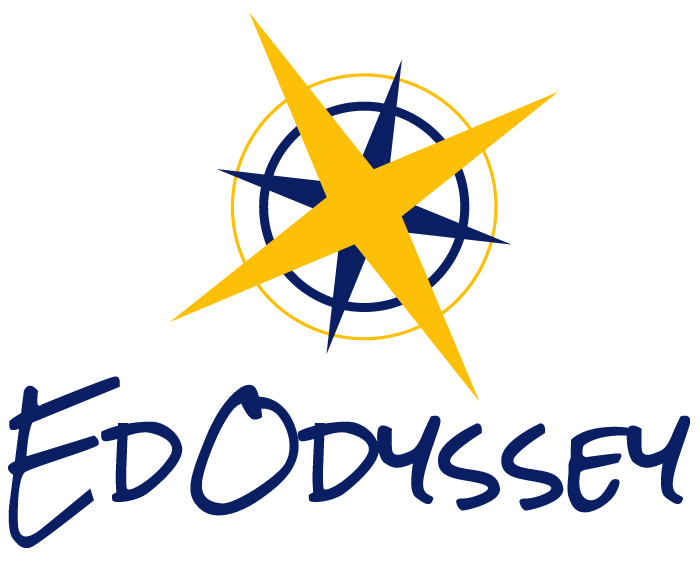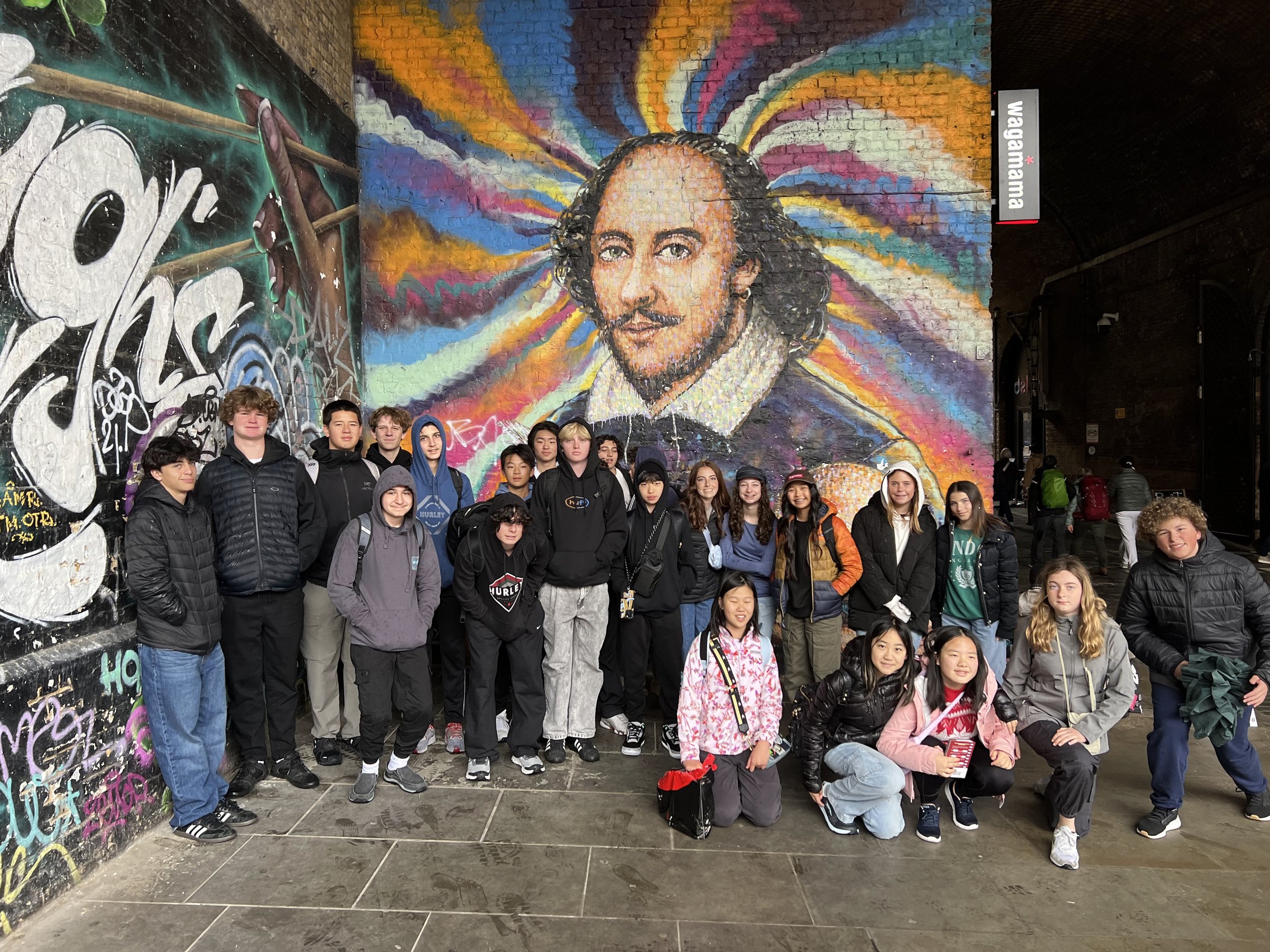Fine Arts & Culture in London: A Field Study with St. Mary’s School
Engaging with our youngest students—our middle schoolers—and sharing adventures with them is a real privilege. Some have traveled previously, but for many, it’s their first international trip, and we are honored to play a role in their experience of the world beyond U.S. borders.
Alongside their course leaders, Kari Greenfield, Rob Warren, and Maureen Baca, our UK Program Leader Jules Sanderson recently hosted an enthusiastic group of middle school students from St. Mary’s School for an action-packed week in London.
“I feel like we pretty much covered every possible London activity,” Jules said. “We also did a fair bit of walking around the city and the students got so good at taking the Tube; I was very impressed!
Experiencing a London airport alone leaves an impression. It’s an introduction to and immediate immersion into a global city home to 287 ethnic groups and nationalities, where more than 300 languages are spoken and 49.5% of the population is bilingual. Even the distinctions between English spoken in the U.S. and the U.K. are apparent from the beginning.
Exploring London
The group settled into a hotel near Marble Arch and Hyde Park.
Over six days, their trip covered six main themes:
LANDMARKS: One of their first activities was a bus tour that gave the students an overview of central London and introduced them to some of the city’s famous landmarks. One of these was the London Eye, which they were able to ride on another day. They also had an opportunity to stroll through Hyde Park and St. James’s Park to see Buckingham Palace up close.
MARKETS: There’s nowhere better to experience the liveliness and multiculturalism of London than in its many markets. The students were able to visit two vastly different examples: Borough Market and Camden Market.
Borough Market—a busy covered food market in London Bridge—is one to visit with an appetite. Vendors sell everything from fresh veggies to fish to prepared dishes from around the globe. Set inside a green wrought iron Victorian structure, it’s a sensory experience: tables heaped with a rainbow of fruits; scents galore: organic earthy wild mushrooms, bubbling raclette cheese, freshly-baked bread, coconut and mango rice; sounds of cooking, laughter, different languages; and glimpses of The Shard and Southwark Cathedral as you near the edges. Its history stretches back 1,000 years.
Camden Market, in North London, began in 1974 and could be described as eclectic, or quirky. Many of the buildings along the high street leading to the market have 3-D sculptural façades: an airplane, giant shoes, a dragon, a scorpion jut out from buildings above small independent shopfronts. The market is a compilation of several areas stretching out in all directions, including along the canal and inside of old horse stables. Camden was famous in the 1960s for its legendary music scene—especially punk and rock bands like The Clash and The Sex Pistols. It was a center of counterculture and the alternative fashion that came along with it. Though the market has changed over the years to include food, tourist tat, and more mainstream fashion, this was once a popular place for mods, bohemians, punks, and rockers to shop. A touch of that vibe still lingers on.
STORYTELLING: Watching a West End musical (“Back to the Future: The Musical”) and a play gave the students some insight into the world of theater in London.
They also tried their hands at an acting class hosted at world-renowned Shakespeare’s Globe Theatre on the south bank of the River Thames. The original Globe Theater was one street back, built in 1599 and destroyed in a 1613 fire. This was where Shakespeare wrote some of his most well-known works: Julius Caesar, Macbeth, Othello, and Hamlet, to name a few. The original Globe was replaced the following year but then turned into tenement buildings in the 1640s. The current version in its riverside location was completed in 1997 following the same building techniques and the same wood as the original and even includes its signature water-reed thatched roof (the only thatched-roof building in London). It’s now a cultural landmark as well as an active theater. The central yard is open-air and performances go ahead in rain, shine, and snow.
Another highlight in the arena of storytelling was a 7-hour-long excursion to the outskirts of the city to visit the Harry Potter Studios to explore behind the scenes in the studios where all eight films were produced and discover the secrets of some of the special effects. Students saw iconic props, costumes and sets, including Hogwarts Great Hall, the Forbidden Forest, the original Hogwarts Express at Platform 9 ¾, Gringotts Wizarding Bank, and Diagon Alley.
SPORTS: Sports fans were thrilled with tours of both the Wimbledon grounds and Chelsea Football Club stadium.
In Wimbledon, they were able to see the grounds used by some of the world’s top tennis players and the facilities used by the broadcasters who cover the world-famous tennis championships. In the museum, there are famous trophies, fabrics of tennis fashion from the Victorian era, and some interactive areas.
In Fulham, the group was able to see the playing field of Chelsea Football Club, one of the most successful soccer teams in the world. They visited the dressing rooms, press room, the player’s tunnel, pitchside, and more while learning about the team’s 118-year history.
HISTORY: On the theme of history, the students took a Yeoman Warder tour of the Tower of London. Through the gruesome and gory—imprisonments, executions, and torture—to some of the more uplifting stories, they learned about the tower’s 1,000-year history.
Another day, the group traveled to the city’s outskirts for a visit to Windsor where they explored the town and toured the castle, which started construction under William the Conqueror in 1070. It’s the longest-occupied palace in Europe, has more than 1,000 rooms, and a 2.65-mile long driveway!
LEISURE: To relax, students had a great time playing a life-sized Monopoly game. They enjoyed playing interactive soccer games at TOCA Social. They also had some time to visit the fashion mecca that is Oxford Street, shop and learn a bit about London’s fashion industry.
FOOD: Of course, they also had some memorable food experiences related to the local culture, like the delicious delights of Borough Market, dinners in bustling Covent Garden, a comforting Sunday roast, high tea, and a dinner cruise on the Thames, to name a few.
Having enjoyed the week with our St. Mary’s students, Jules noted that, “Lifesize Monopoly, the roast dinner, Camden Market, Harry Potter studios, Chelsea FC stadium, and the acting class at The Globe were real highlights.”
Thank you, St. Mary’s!
We welcome these students to join us again on a First Year Experience or even a semester abroad when they reach university.
Benefits of educational travel
Educational travel of any length and at any age has so many benefits, from helping students develop different perspectives, cultural competence, empathy, and an understanding of global issues to more personal skills like self-confidence, resilience, flexibility, adaptability, independence, and curiosity.
Taking your classroom beyond its four walls can improve student engagement and motivation, and real-world experiences can enrich your curriculum, reinforce lessons, and foster a deeper understanding of academic subjects. Beyond academics, group travel can strengthen friendships and create life-long memories!
If you’re interested in organizing a custom UK trip for your own group of middle schoolers, reach out to start a conversation.














